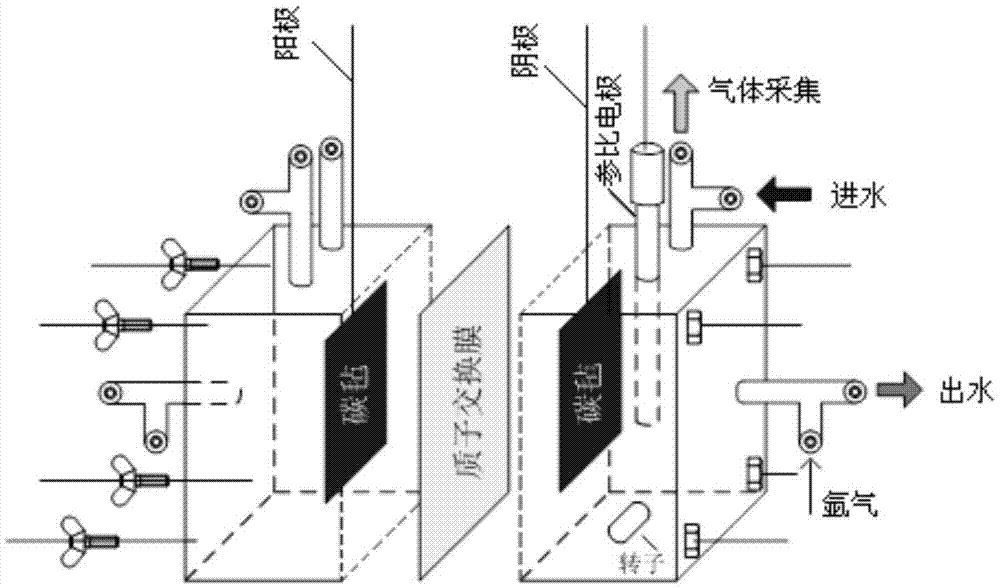Construction method of microbial electrochemical system for hydrogen phosphide generation reinforcement
A technology of microbial electrochemistry and construction method, applied in the field of microbial electrochemistry, to achieve the effects of convenient operation, shortened start-up time, and convenient material collection
- Summary
- Abstract
- Description
- Claims
- Application Information
AI Technical Summary
Problems solved by technology
Method used
Image
Examples
Embodiment 1
[0033] (1) Enrichment culture of phosphine-producing microorganisms outside the microbial electrolytic cell: 300 g of pig manure, 300 g of anaerobic sludge and 1 L of medium were added to a 3L brown anaerobic bottle. The medium used methanol as a carbon source and COD as 800mg / L, dipotassium hydrogen phosphate as phosphorus source, TP is 50mg / L; ammonium chloride is used as nitrogen source, TN is 30mg / L. Trace element nutrient solution, the addition amount is 1ml / L. The culture medium was ventilated with argon gas for 5 minutes to remove oxygen before use, and cultured anaerobically at 35°C in an incubator, with pH 6.5 and ORP in the range of 380-400mv. Each cycle is 4 days, and the enrichment of phosphine-producing microorganisms is completed after 8 cycles to obtain a domesticated activated sludge mixture rich in phosphine-producing microorganisms.
[0034] (2) Take 10mL of the acclimated activated sludge mixture, centrifuge at 3000r / min for 10min in a centrifuge, wash with...
Embodiment 2
[0037] (1) Enrichment culture of phosphine-producing microorganisms outside the microbial electrolytic cell: 300 g of pig manure, 300 g of anaerobic sludge and 1 L of medium were added to a 3L brown anaerobic bottle. The medium used methanol as a carbon source and COD as 800mg / L, dipotassium hydrogen phosphate as phosphorus source, TP is 50mg / L; ammonium chloride is used as nitrogen source, TN is 30mg / L. Trace element nutrient solution, the addition amount is 1ml / L. The culture medium was ventilated with argon gas for 5 minutes to remove oxygen before use, and cultured anaerobically at 35°C in an incubator, with pH 6.5 and ORP in the range of 380-400mv. Each cycle is 4 days, and the enrichment of phosphine-producing microorganisms is completed after 8 cycles to obtain a domesticated activated sludge mixture rich in phosphine-producing microorganisms.
[0038] (2) Take 10mL of the acclimated activated sludge mixture, centrifuge at 3000r / min for 10min in a centrifuge, wash with...
Embodiment 3
[0041](1) Enrichment culture of phosphine-producing microorganisms outside the microbial electrolytic cell: 300 g of pig manure, 300 g of anaerobic sludge and 1 L of medium were added to a 3L brown anaerobic bottle. The medium used methanol as a carbon source and COD as 800mg / L, dipotassium hydrogen phosphate as phosphorus source, TP is 50mg / L; ammonium chloride is used as nitrogen source, TN is 30mg / L. Trace element nutrient solution, the addition amount is 1ml / L. The culture medium was ventilated with argon gas for 5 minutes to remove oxygen before use, and cultured anaerobically at 35°C in an incubator, with pH 6.5 and ORP in the range of 380-400mv. Each cycle is 4 days, and the enrichment of phosphine-producing microorganisms is completed after 8 cycles to obtain a domesticated activated sludge mixture rich in phosphine-producing microorganisms.
[0042] (2) Take 10mL of the acclimated activated sludge mixture, centrifuge at 3000r / min for 10min in a centrifuge, wash with ...
PUM
| Property | Measurement | Unit |
|---|---|---|
| diameter | aaaaa | aaaaa |
| thickness | aaaaa | aaaaa |
Abstract
Description
Claims
Application Information
 Login to View More
Login to View More - Generate Ideas
- Intellectual Property
- Life Sciences
- Materials
- Tech Scout
- Unparalleled Data Quality
- Higher Quality Content
- 60% Fewer Hallucinations
Browse by: Latest US Patents, China's latest patents, Technical Efficacy Thesaurus, Application Domain, Technology Topic, Popular Technical Reports.
© 2025 PatSnap. All rights reserved.Legal|Privacy policy|Modern Slavery Act Transparency Statement|Sitemap|About US| Contact US: help@patsnap.com

